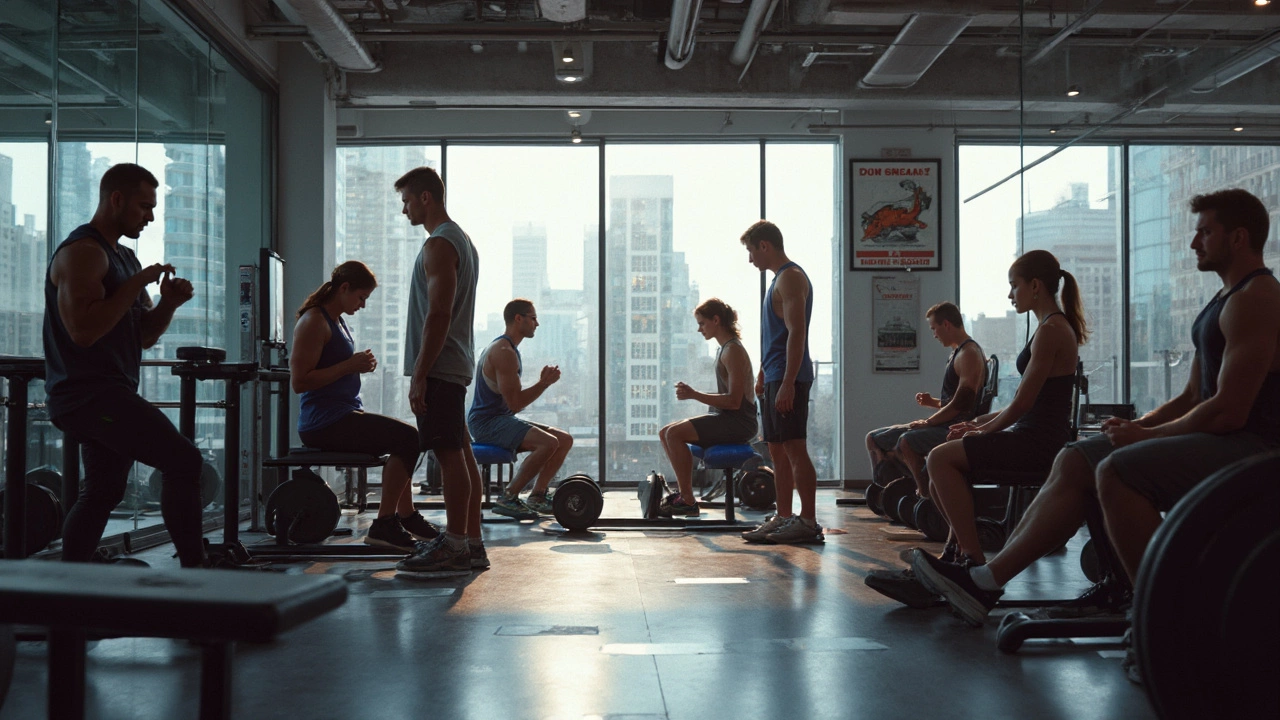
Been eyeing those gym regulars who never seem to take a day off? Or maybe your TikTok feed is full of people pushing five-day lifting streaks. The big question—does working out with weights five days in a row help you grow faster, or are you just flirting with burnout?
Here’s the first thing to know: muscles don’t get stronger in the gym. They get stronger when you rest. Every time you lift, you make micro-tears in your muscle fibers. Your body needs time—usually between 24 and 72 hours—to repair those tears and come back even stronger. If you jump from one lifting session straight into another for five days, some muscle groups might not get the downtime they actually need.
But it’s not just about being sore. Training too much without enough recovery can mess with your mood, drain your energy, and even slow down muscle gains. Ever notice yourself losing motivation or getting crabby for no reason? Sometimes, that’s your body waving a red flag.
Five days of lifting isn’t always too much, but it depends a lot on what exercises you’re doing, how hard you push, and whether you’re getting smart sleep and nutrition. Ready to break down what your muscles can handle and how to make sure you’re training—not just grinding? Keep reading for tips that go beyond the usual bro-science.
- What Happens When You Lift Five Days Straight
- Signs You're Overdoing It
- How Much Rest Do Your Muscles Really Need?
- Smart Ways to Structure Your Training Week
What Happens When You Lift Five Days Straight
Let’s cut to the chase: hitting the weights for five days in a row is going to affect your body differently depending on how you train, your recovery, and personal fitness level. If your routine mixes muscle groups and intensity, you might handle it fine. But if you’re going all-out with heavy lifts or working the same muscle group over and over, you risk stalling progress and feeling wiped out.
When you work out day after day, your central nervous system gets taxed. Even if your muscles don’t feel super sore, your “engine”—think energy, sleep, mood, and motivation—can run low. A research review in Current Sports Medicine Reports found that strength athletes saw a dip in performance and recovery if they skipped rest days for too long.
Here’s a glance at what might happen to your body over five straight days of lifting:
- Joint and tendon stress stacks up, not just muscle soreness
- Muscles can feel weaker, not stronger, if recovery tanks
- Quality of your lifts—form, power, range of motion—often drops
- Your sleep can take a hit, which messes with recovery
- Fatigue creeps up so motivation nosedives
If you’re still not sure if it’s too much, numbers tell a story too. Check out this quick data table—these stats are from a 2022 survey by the International Health, Racquet & Sportsclub Association (IHRSA) and a recent clinical trial on lifting frequency:
| Training Schedule | Average Strength Gain (8 weeks) | Reported Fatigue | Injury Rate |
|---|---|---|---|
| 3 Days/Week (full body) | 21% | Low | 2% |
| Lifting 5 days (split routine) | 22% | Moderate | 4% |
| 6+ Days/Week | 20% | High | 7% |
So yes, you can make gains lifting five days, but you’re also likely to feel more tired and bump up your risk of overuse issues compared to those who space out sessions. The sweet spot depends on how you build your week and support your body with rest, food, and sleep. It’s not just about clocking days—it’s about how you stack up the workload.
Signs You're Overdoing It
You might be crushing your workouts, but your body will start telling you if five days in a row is too much. Sure, a little soreness is normal, but if you’re feeling way more tired or beat up than usual, it could be a sign that your body needs a break.
Some of the most common signals go beyond just sore muscles:
- Unusual fatigue — Feeling wiped out all day? That constant tiredness can mean your body isn’t keeping up with repairs.
- Performance drop — Noticing your weights feel heavier, or you’re missing reps you usually nail? That’s another red flag.
- Lingering muscle soreness — If you’re still hurting two or three days after your workout, your recovery isn’t on track.
- Bad sleep — Overtraining can mess with your sleep, so if you’re tossing and turning at night, don’t brush it off.
- Irritability or mood swings — If you’re snapping at people or feeling off without any clear reason, stress from too much training might be the culprit.
- Getting sick more easily — Overdoing it can mess with your immune system, making you catch colds more often.
Wondering how common this is? Check out this quick look at reported overtraining symptoms among people who hit the gym five or more days a week:
| Symptom | Percentage Reporting |
|---|---|
| Fatigue | 62% |
| Sleep Issues | 46% |
| Mood Swings | 39% |
| Increased Injury | 33% |
| Weak Immune System | 27% |
These numbers aren’t just random. Even coaches and sports dietitians report these issues showing up in lifters who push through five or more “work until failure” sessions each week. If you want to keep seeing results from your lifting 5 days per week, it pays to listen to your body and spot these signs early.
A quick tip: Track your most recent lifts, sleep hours, and overall mood for a week or two. If you see a dip in any area, that’s your cue to work in a rest or lighter day. You’re better off pausing than sidelined by burn-out or injury.

How Much Rest Do Your Muscles Really Need?
Let’s talk numbers. Most research says that a muscle group needs about 48 hours to recover after a tough workout. This doesn’t mean you have to sit on the couch for two days—just avoid training the exact same muscle group back-to-back. For example, if you hammered your legs on Monday, don't hit them again on Tuesday. Your muscles need that downtime to get stronger, not just bigger.
Why so much rest? When you work out hard, your muscle fibers literally tear and break down. Your body jumps into fix-it mode—building those fibers up even tougher, but it only happens while you’re resting. Skip recovery, and you risk stalling your progress or even getting injured.
It’s not just about muscles, either. Your nervous system and joints need breaks, too, especially if you’re going heavy or doing explosive lifts. Ever felt wiped out or weirdly clumsy the next day? That’s recovery gone bad.
- For beginners, two or three full-body sessions a week with a rest day in between usually gets results without burning you out.
- If you’re on a split routine (like push, pull, legs), training five days in a row can work—but only if you rotate muscle groups so each one still gets a break.
- Sleep is a secret weapon. Aim for at least 7 hours a night if you actually want those repairs happening.
- Active recovery days—like walking or yoga—can help move soreness along instead of just sitting still.
The takeaway: even if you love lifting 5 days a week, your body works better with a smart balance between action and rest. Don’t let FOMO push you into junk workouts; make those rest days count, and your gains will come faster.
Smart Ways to Structure Your Training Week
You want to hit the gym lifting 5 days in a row, but you don’t want to tank your energy or kill your gains. The trick? Instead of blasting every muscle every day, split up your workouts with a plan that gives each muscle group enough recovery. This way, you avoid overtraining and actually make better progress.
Classic routines most trainers swear by include the "Push/Pull/Legs" split. You work pushing muscles (like chest, shoulders, and triceps) one day, pulling muscles (back and biceps) the next, and then legs. Repeat that cycle to cover your five days. Or, you can do "Upper/Lower Body Splits," hitting upper body one day, lower body the next, and cycling through for the week. Both methods give your muscles 48–72 hours rest, which is the sweet spot according to the American College of Sports Medicine.
Here’s how a sample five-day week could look:
- Day 1: Push (chest, shoulders, triceps)
- Day 2: Pull (back, biceps)
- Day 3: Legs (quads, hamstrings, calves)
- Day 4: Upper Body
- Day 5: Lower Body
If you want more variety, try swapping in a day for mobility work or low-impact cardio, which can help you recover while still moving.
Recovery is non-negotiable, even if you rotate muscle groups. Research from the Journal of Strength and Conditioning Research shows performance drops and injury risk jumps in people who barely take rest days. Active rest—like a walk, stretching, or yoga—can speed up muscle repair and keep you from burning out.
Take a look at what a balanced weekly structure can look like for people at different levels:
| Experience Level | Type of Split | Fall-Back/Rest Days |
|---|---|---|
| Beginner | Full body every other day | 2 days full rest |
| Intermediate | Push/Pull/Legs, with two repeat days | 1-2 days active recovery |
| Advanced | Body part splits (e.g., chest, back, legs, shoulders, arms) | 1 day full rest, 1 day active recovery |
To stay consistent and avoid major dips in motivation, mix in workouts that feel fun, not just exhausting. Track how you feel after each session—the best structured plan is the one you stick to without dragging yourself through the entire week. And if life happens and you need a real rest day, take it. Your muscles—and your mind—will thank you.
